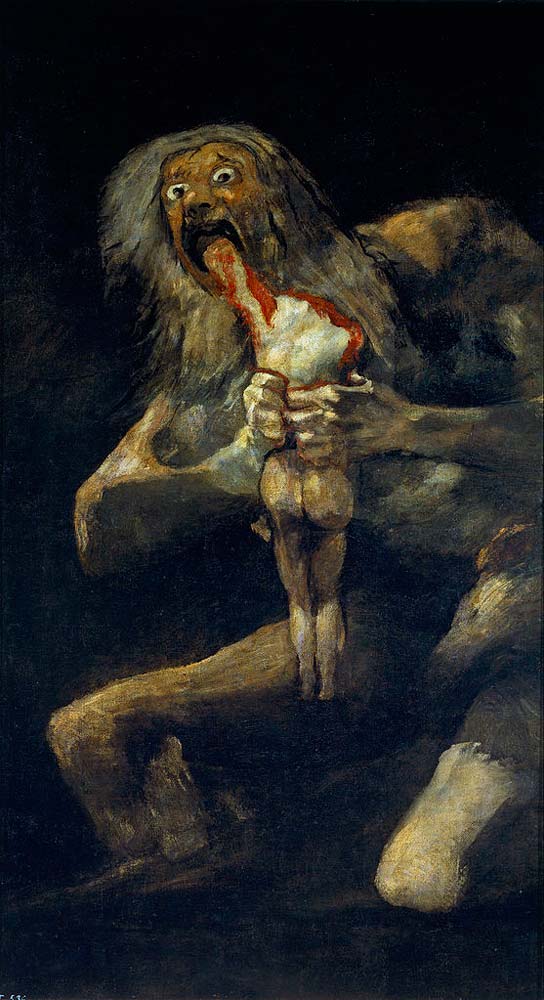| Saturn Devouring His Son | |
|---|---|
 |
|
| Artist | Francisco de Goya |
| Year | c. 1819–1823 |
| Medium | Oil mural transferred to canvas |
| Location | Museo del Prado, Madrid |
| Dimensions | 56.2 x 31.8 in 143 x 81 cm |
| Famous Paintings by Goya | |
| Saturn Devouring His Son | |
| The Third of May 1808 | |
| La Maja Desnuda | |
| The Sleep of Reason Produces Monsters | |
| Witches’ Sabbath | |
| La Maja Vestida | |
| La Cometa | |
| The Forge | |
| The Dog | |
| Complete Works |
Painted upon the plaster walls of his humble abode, Saturn Devouring His Son is one of the works by Francisco Goya that falls within the classification of the “Black Paintings” of Goya. Goya, a Spanish artist who did not intend for these paintings to be viewed by the public (he received no commission for them) has been viewed by some as artistically insane, yet others believe he was simply expressing his own bitterness toward the general human condition.
The Legend
The painting depicts one of the Greek titans, Saturn, in a crazed state as he wildly consumes the body of one of his sons. According to legend, Saturn, who had overthrown his own father, learned of a prophecy in which it was foretold that one of his own sons would overthrow his power in similar fashion. Obsessed with preventing the prophecy from being fulfilled, Saturn devoured each of his children as soon as they were born. His wife successfully hid his last child, Jupiter, from Saturn and the prophecy was later fulfilled.
Details & Description
The very macabre presentation of the painting is, at best, disturbing. Goya’s limited use of bright colors as seen in the whites of his eyes, the whitening of his knuckles as he grasps the child’s body, and the brash paleness of the dead child’s backside with the redness of the blood are in stark contrast to the dark and gloomy colors that were otherwise used in the painting.
Goya depicts Saturn as a crazed titan/man that is eating child frantically, with the head, left arm, and part of the shoulder of the child obviously already devoured. It has been rumored that, at the time the painting was discovered, the portrayal of Saturn included a state of sexual arousal as he consumed the child. However, this has not been confirmed and, due to the deterioration that has occurred in the plaster, no such condition has since been visible.
It is also entirely possible that, if the arousal was present in the painting, it may have been deliberately altered before placing in public view, especially since Goya had never intended for this or any other paintings in the “Black” series to be viewed by the public.
In his later years, Goya went into complete exile and left the house that contained the murals to his grandson. The house eventually became the property of Emile d’Erianger in 1874, who commissioned the murals to be painstakingly transferred to canvas and preserved due to the fact that the walls of the house were deteriorating rapidly.
Speculation about the Source
Many theories abound as to what would cause Goya to paint such morbid pieces, and do so upon the walls of his home. A further irony is that Goya chose his dining area for painting the mural of Saturn Devouring His Son.
Some believe that Goya was so embittered by the political unrest of his beloved Spain that he felt the need to express his bitterness through his art. They assert that he was using symbolism, with Spain being the son and the oppressors being Saturn. Others believe the painting is a twisted representation of his relationship with his own sons.
Regardless of the motive behind it, Saturn Devouring His Son is a disturbing portrayal of conflict, fear, and the bloodlust that can accompany the lust for power.